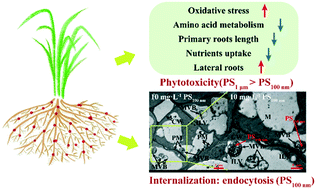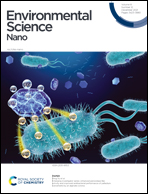Polystyrene microplastic interaction with Oryza sativa: toxicity and metabolic mechanism†
Abstract
Little is known about the effects of microplastics on terrestrial ecosystems, especially agricultural soils and terrestrial higher plants. Here, rice seedlings were exposed to two different-sized polystyrene (PS) microplastics (100 nm and 1 μm) at 0, 0.1, 1 and 10 mg L−1 under hydroponic conditions for 2 weeks to investigate the metabolic mechanism of PS-induced phytotoxicity and the internalization of PS in rice. PS can trigger oxidative stress. Metabolomic analysis showed that rice leaves had a stronger metabolic response than roots, and the influence of PS on rice metabolic profile was dose-dependent. Metabolic pathways, especially amino acid metabolism, were regulated to affect the growth and development of rice. Phenotypic indexes are consistent with the results of metabolomics. The primary root length of rice was decreased and the nutrient uptake was inhibited, while lateral roots were stimulated to grow to meet the nutritional requirement. Moreover, we found that PS100 nm rather than PS1 μm can be effectively accumulated in rice roots through endocytosis, although PS1 μm exhibited stronger phytotoxicity than PS100 nm. Our study provides direct evidence for the negative effects of PS on rice, which may have significant implications for assessing the risk of microplastics to terrestrial ecosystems.



 Please wait while we load your content...
Please wait while we load your content...